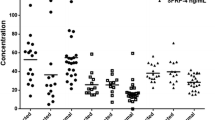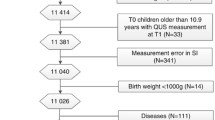Abstract
Collagen X marker (CXM) is a degradation fragment of collagen type X. It is a real-time biomarker of height velocity with established norms. Plasma C-type natriuretic peptide (CNP) and NTproCNP levels have also been found to correlate with growth velocity in the general population and are elevated in individuals with achondroplasia compared with age- and sex-matched controls. Collagen X marker levels in people with fibroblast growth factor receptor 3 (FGFR3)-opathies have never been systematically measured. The objective of this study was to measure CXM in a population of dwarfism caused by FGFR3-opathies. Using the same cohort in which CNP and NTproCNP levels were previously measured, archived serum aliquots from 63 children with achondroplasia, six with hypochondroplasia, and two with thanatophoric dysplasia had CXM concentrations measured. Results were plotted against age- and sex-specific norms, and standard deviation scores were plotted for comparison between clinical diagnoses. CXM levels were significantly decreased (p < 0.0001) in children with achondroplasia compared with age- and sex-matched controls. Temporal patterns of change in CXM levels were sex-dependent. As the FGFR3 pathway was more constitutively active, CXM levels decreased. New tools are emerging to study impact of skeletal dysplasia on growth plate regulation and function.




Similar content being viewed by others
Data Availability
Some or all datasets generated during and/or analyzed during the current study are not publicly available but are available from the corresponding author on reasonable request.
References
Ornitz DM, Legeai-Mallet L (2017) Achondroplasia: development, pathogenesis, and therapy. Dev Dyn 246(4):291–309. https://doi.org/10.1002/dvdy.24479
Olney RC, Permuy JW, Prickett TC, Han JC, Espiner EA (2012) Amino-terminal propeptide of C-type natriuretic peptide (ntprocnp) predicts height velocity in healthy children. Clin Endocrinol (Oxf) 77(3):416–422. https://doi.org/10.1111/j.1365-2265.2012.04392.x
Espiner E, Prickett T, Olney R (2018) Plasma C-type natriuretic peptide: emerging applications in disorders of skeletal growth. Horm Res Paediatr 90(6):345–357. https://doi.org/10.1159/000496544
Krejci P, Masri B, Fontaine V, Mekikian PB, Weis M, Prats H, Wilcox WR (2005) Interaction of fibroblast growth factor and C-natriuretic peptide signaling in regulation of chondrocyte proliferation and extracellular matrix homeostasis. J Cell Sci 118(Pt 21):5089–5100. https://doi.org/10.1242/jcs.02618
Olney RC, Prickett TC, Espiner EA, Mackenzie WG, Duker AL, Ditro C, Zabel B et al (2015) C-type natriuretic peptide plasma levels are elevated in subjects with achondroplasia, hypochondroplasia, and thanatophoric dysplasia. J Clin Endocrinol Metab 100(2):E355–E359. https://doi.org/10.1210/jc.2014-2814
Coghlan RF, Oberdorf JA, Sienko S, Aiona MD, Boston BA, Connelly KJ, Bahney C et al (2017) A degradation fragment of type X collagen is a real-time marker for bone growth velocity. Sci Transl Med 9(419):4669. https://doi.org/10.1126/scitranslmed.aan4669
Coghlan RF, Olney RC, Boston BA, Coleman DT, Johnstone B, Horton WA (2021) Norms for clinical use of CXM, a real-time marker of height velocity. J Clin Endocrinol Metab 106(1):e255–e264. https://doi.org/10.1210/clinem/dgaa721
Savarirayan R, Irving M, Bacino CA, Bostwick B, Charrow J, Cormier-Daire V, Le Quan Sang KH et al (2019) C-Type natriuretic peptide analogue therapy in children with achondroplasia. N Engl J Med 381(1):25–35. https://doi.org/10.1056/NEJMoa1813446
Koenker RW, d’Orey V (1987) Algorithm as 229: computing regression quantiles. J R Stat Soc Ser C Appl Stat 36(3):383–393. https://doi.org/10.2307/2347802
Wagner BM, Robinson JW, Lin YW, Lee YC, Kaci N, Legeai-Mallet L, Potter LR (2021) Prevention of guanylyl cyclase-B dephosphorylation rescues achondroplastic dwarfism. JCI Insight 6(9):147832. https://doi.org/10.1172/jci.insight.147832
Yasoda A, Komatsu Y, Chusho H, Miyazawa T, Ozasa A, Miura M, Kurihara T et al (2004) Overexpression of CNP in chondrocytes rescues achondroplasia through a MAPK-dependent pathway. Nat Med 10(1):80–86. https://doi.org/10.1038/nm971
Merker A, Neumeyer L, Hertel NT, Grigelioniene G, Makitie O, Mohnike K, Hagenas L (2018) Growth in achondroplasia: development of height, weight, head circumference, and body mass index in a European cohort. Am J Med Genet A 176(8):1723–1734. https://doi.org/10.1002/ajmg.a.38853
Hoover-Fong JE, Schulze KJ, Alade AY, Bober MB, Gough E, Hashmi SS, Hecht JT et al (2021) Growth in achondroplasia including stature, weight, weight-for-height and head circumference from CLARITY: achondroplasia natural history study–a multi-center retrospective cohort study of achondroplasia in the US. Orphanet J Rare Dis 16(1):522. https://doi.org/10.1186/s13023-021-02141-4
Ozasa A, Komatsu Y, Yasoda A, Miura M, Sakuma Y, Nakatsuru Y, Arai H et al (2005) Complementary antagonistic actions between C-type natriuretic peptide and the MAPK pathway through FGFR-3 in ATDC5 cells. Bone 36(6):1056–1064. https://doi.org/10.1016/j.bone.2005.03.006
Del Pino M, Fano V, Adamo P (2019) Height growth velocity in infancy and childhood in achondroplasia. Am J Med Genet A 179(6):1001–1009. https://doi.org/10.1002/ajmg.a.61120
Acknowledgements
We thank all the families who participated in this research. This new insight into biomarkers in FGFR3-opathies would not be possible without their contribution. This work was supported in part by the Growing Stronger Foundation, developmental funds from Nemours, and Shriners Hospital research grant. Work was additionally funded by NIH (Grant R21AR065657 WAH), and the Bill and Melinda Gates Foundation (Grant OPP1106834 WAH).
Funding
This work was supported in part by the Growing Stronger Foundation, developmental funds from Nemours, and Shriners Hospital research grant. Work was additionally funded by NIH (Grant R21AR065657 WAH), and the Bill and Melinda Gates Foundation (Grant OPP1106834 WAH).
Author information
Authors and Affiliations
Contributions
RSC guarantor, data acquisition, interpretation, writing, RCO study design, data analysis, interpretation, writing, ALD data acquisition, interpretation, writing, RFC data acquisition, WGM study design, data acquisition, CPD data acquisition, CJB data acquisition, DAC data analysis, interpretation, WAH data acquisition, data analysis, BJ data acquisition, data analysis, EAE study design, interpretation, writing, TCRP study design, interpretation, writing, MBB study design, data acquisition, data analysis, interpretation, writing.
Corresponding author
Ethics declarations
Conflicts of interest
CJB, ALD, BJ, DAO’C, RCO have no disclosure information relevant to this work. CPD received lecture fees from BioMarin. RFC & WAH are inventors on a patent entitled, “Type X collagen assay and methods of use thereof,” filed by Shriners Hospital for Children. EAE & TCRP have filed a patent entitled, “Assessment of skeletal growth using measurements of NT-CNP peptides.” MBB, RFC, WAH, have consulted for TherAchon/Pfizer and QED. MBB, RFC, EAE, WAH, WGM have consulted for BioMarin. WAH has consulted for Relay Therapeutics.
MBB, WAH have consulted for Ascendis. MBB and RSC receive research funding from Biomarin, TherAchon/Pfizer, Ascendis, and QED.
Ethical Approval
The original study was approved by the Nemours Florida Institutional Review Board. The study was performed in accordance with the ethical standards as laid down in the 1964 Declaration of Helsinki and its later amendments or comparable ethical standards.
Informed Consent
All children had written parental permission obtained. Parental permission forms included authorization to archive and use blood samples for future research studies.
Additional information
Publisher's Note
Springer Nature remains neutral with regard to jurisdictional claims in published maps and institutional affiliations.
Rights and permissions
About this article
Cite this article
Carroll, R.S., Olney, R.C., Duker, A.L. et al. Collagen X Marker Levels are Decreased in Individuals with Achondroplasia. Calcif Tissue Int 111, 66–72 (2022). https://doi.org/10.1007/s00223-022-00966-0
Received:
Accepted:
Published:
Issue Date:
DOI: https://doi.org/10.1007/s00223-022-00966-0




